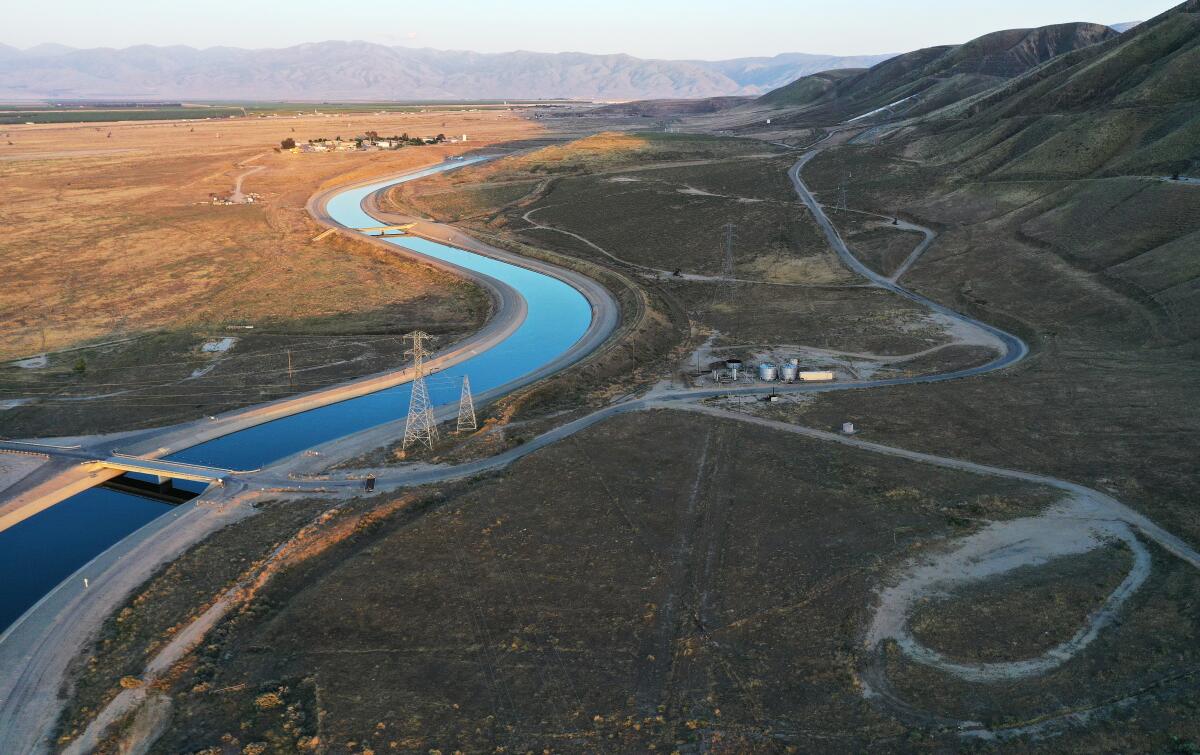Metropolitan Water District declares drought emergency in Southern California

- Share via
Southern California’s largest urban water district declared a drought emergency on Tuesday and called for local water suppliers to immediately cut the use of water from the State Water Project.
The resolution passed by the board of the Metropolitan Water District of Southern California calls on people across the region to step up conservation efforts, but also focuses especially on six water agencies that rely heavily or entirely on the water-starved State Water Project.
Those water agencies, which supply cities in Los Angeles, Ventura and San Bernardino counties, have been instructed to activate additional conservation measures and reduce their usage of water from the State Water Project, which is in an acute shortage after one of the state’s driest years on record.
“We are focusing on getting the message out throughout our service area that people need to ramp up their focus on conservation,” Assistant General Manager Deven Upadhyay said.
He said the declaration of a drought emergency is intended to support Gov. Gavin Newsom’s call for Californians to voluntarily reduce water use by 15%, but it’s also intended to focus on needed actions by the subset of MWD’s member agencies that depend on the State Water Project.
“Those are the areas that we really need to respond right now,” Upadhyay said. “We’re asking them to immediately take actions to increase conservation in order to preserve State Water Project supplies.”
California’s last two water years, which ended Sept. 30, were the driest two-year period in more than a century of records based on precipitation. And the dryness has been intensified by extreme heat unleashed by global warming.
Although storms in October brought heavy rains across Northern California and helped to raise the levels of reservoirs, the supplies of the State Water Project remain depleted.
This year, with the state’s major reservoirs at some of their lowest levels ever, water agencies received just 5% of their full allocations from the State Water Project. Next month, state water officials are expected to announce an initial zero-percent allocation for 2022.
The allocation typically changes as the year progresses, depending on the amount of snow and rain, and the outlook could improve. But by how much is uncertain. In the meantime, managers of agencies that rely on the State Water Project are being told to prepare for much less water.
MWD imports water from the State Water Project and the Colorado River, supplying 19 million people across six counties. Both sources are facing shortages.
The State Water Project delivers water from the Sacramento-San Joaquin River Delta to farmland and cities to the south. Built in the 1960s and early 70s, the project includes canals, pipelines, reservoirs and pumping facilities.
For now, California’s allotments of Colorado River water haven’t been cut back like those of Arizona and Nevada, but that could change as the water level of Lake Mead continues to decline toward more severe shortage levels.
For now, MWD officials said, drought conditions are especially severe on the State Water Project and require immediate action.
Areas that depend on the State Water Project are supplied by six agencies: Los Angeles Department of Water and Power, Calleguas Municipal Water District, Las Virgenes Municipal Water District, Upper San Gabriel Valley Municipal Water District, Three Valleys Municipal Water District and Inland Empire Utilities Agency.
LADWP officials urged customers to redouble their efforts to save water.
“The drought that we are currently facing is serious,” said Anselmo Collins, senior assistant general manager of LADWP’s water system. “We urge everyone to take a closer look at how they are using water inside and outside their home because the water we save now is water in our reservoirs for next spring and summer.”
Los Angeles officials announced last month that the city began taking less water from the State Water Project and receiving additional Colorado River water.
MWD acts as a water wholesaler, supplying water to 26 member cities and agencies. Officials of each local water supplier will decide how to respond to MWD’s drought declaration.
Upadhyay said MWD is asking the six agencies that depend on the State Water Project to “implement actions that they deem necessary under their own water shortage contingency plans,” which they’ve submitted to the state.
For some agencies, the response may be moving to enforce restrictions limiting the days of the week when outdoor watering is allowed, Upadhyay said. For other agencies that have rates based on water-budgets that incentivize conservation, he said, one approach could be to lower the amount of water allowed under the first-tier price before there is a higher rate for exceeding that amount.
“Each agency is likely to take slightly different sets of actions,” Upadhyay said. “We’re trying to make these supplies that are currently available in the State Water Project system last as long as possible, until we do get an allocation announcement that is something different than zero.”
MWD officials said they recognize that the situations of different water agencies vary depending on their available supplies and local circumstances. In their resolution, the MWD board called for water agencies to reduce their use of supplies from the State Water Project and to immediately implement conservation requirements and restrictions to achieve those reductions.
The board of Calleguas Municipal Water District in Ventura County will soon take up a proposal to implement additional water conservation measures, aiming to achieve 15% reductions in water use, said Dan Drugan, the district’s manager of resources.
“What that means is some of our cities, they might move forward with stricter irrigating schedules,” Drugan said. “And we’ve already seen that in Simi Valley. Right now, they’ve moved to two-day-a-week watering.”
Other drought restrictions include prohibitions on hosing down driveways or sidewalks, Drugan said, and there may also be more local officials patrolling the streets to prevent overwatering and waste.
MWD said in a statement that this year it has taken “extraordinary actions” to preserve supplies from the State Water Project by delivering Colorado River water to as much of the region as possible. That has required upgrading a pump station to allow moving Colorado River farther west, into the San Fernando Valley and southern Ventura County.
“Our Colorado River supplies are finite as well — there is a drought on that system, too — so we need everyone to use water wisely,” MWD Chair Gloria Gray said in a statement. “But the urgency now is on the State Water Project. That’s why we’re calling for increased conservation in those dependent areas.”
In another step to boost conservation, the MWD board expanded several water-saving programs, increasing rebates for grass removal and providing additional funding for programs to help pay for water-efficient toilets and devices.
Gray said the immediate focus is on stretching the limited supplies from the State Water Project in case the allocation of zero water persists.
Southern California on average gets about one-third of its water from Northern California through the pumps and aqueducts of the project, she said. “Next year, we’ll be lucky to get a small fraction of that.”







